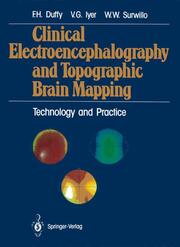Detailansicht
Clinical Electroencephalography and Topographic Brain Mapping
Technology and Practice
ISBN/EAN: 9781461388289
Umbreit-Nr.: 4371550
Sprache:
Englisch
Umfang: xi, 304 S.
Format in cm:
Einband:
kartoniertes Buch
Erschienen am 10.01.2012
Auflage: 1/1989
- Zusatztext
- Electroencephalography is truly an interdisciplinary endeavor, involving concepts and techniques from a variety of different disciplines. Included are basic physics, neuro physiology, electrophysiology, electrochemistry, electronics, and electrical engineer ing, as well as neurology. Given this interesting and diverse mixture of areas, the train ing of an EEG technician, a neurology resident, or an EEG researcher in the basics of clinical electroencephalography presents an uncommon challenge. In the realm of technology, it is relatively easy to obtain a technically adequate EEG simply by learning to follow a protocol and by correctly setting the various switches on the EEG machine at the right time. But experience has shown that the ability to obtain high-quality EEGs on a routine, day-to-day basis from a wide variety of patients requires understanding and knowledge beyond what is learned by rote. Likewise, knowledge above and beyond what is gained by simple participation in an EEG reading is necessary to correctly and comprehensively interpret the record. Such knowledge comes from an understanding of the basic principles upon which the practice of clinical EEG is founded - principles that derive from the various disciplines cited.
- Autorenportrait
- Inhaltsangabe1. Brain Electrical Activity: An Introduction to EEG Recording.- Historical Perspective.- Recording Bioelectric Activity.- Some Characteristics of the EEG.- The EEG Frequency Spectrum.- Fourier Series and Power Spectral Analysis.- Recording EEGs.- The EEG Machine: An Overview.- Computerized EEG Machines.- 2. Basic Electrical Concepts.- Electrical Currents.- Atomic Structure.- Conductors and Insulators.- Potential Difference and Voltage.- Resistance.- Electrical Circuits.- Ohm's Law.- Series and Parallel Circuits.- Circuit Parameters.- Capacitance.- Transient Response.- Series R-C Circuit.- Time Constant.- AC and DC.- AC Circuits.- Impedance.- Frequency Response.- 3. The Differential Amplifier.- Historical Background.- Single-Ended Amplifier.- Amplifying Bioelectric Activity.- The Differential Amplifier-Basic Concept.- Common-Mode Rejection.- Sensitivity or Gain.- Amplifier Noise.- Input Impedance.- Special-Purpose Connections.- The EEG Amplifier as a Whole.- 4. Filters.- The Need for Filtering.- Basic Concept and Function.- Low-Frequency Filter.- Low-Frequency Response-Asymptote Plot.- High-Frequency Filter.- High-Frequency Response-Asymptote Plot.- High- and Low-Frequency Response Combined-The True Curve.- 60-Hz Notch Filter.- Interpreting the Frequency-Response Curve and the Use of Filters.- Summary.- 5. The Writer Unit.- Penmotors.- Penmotor Frequency Response.- Pens.- Error of the Arc.- Pen Mounts.- Inking System.- Inking-System Maintenance.- Chart Drive.- Marker Pens.- 6. Calibration and Calibration Methods.- Purpose and Basic Concept.- Voltage Calibration-Deflection Sensitivity.- Linearity.- Frequency Response.- Biological Calibration.- Noise Level.- Postcalibration.- 7. Recording Electrodes.- Basic Concepts.- Ions.- The Electrical Double Layer.- Polarization and the Double Layer.- Electrode Potentials.- Residual Potentials.- Types of Electrodes.- Application of Surface Electrodes.- Electrode Impedance.- Factors Affecting Electrode Impedance.- Electrode-Induced Artifacts.- Detection of Electrode Artifacts.- Impedance-Measuring Devices.- 8. Electrical Safety.- Macroshock and Microshock.- Ground and Grounding.- Leakage Currents.- Patient Grounding.- Effect of Patient Impedance.- The EEG Technician's Role in Patient Safety.- Isolated Ground and Biopotential Isolator.- Ground Loops.- 9. Elementary Practical Troubleshooting Methods.- Basic Principles.- Single-Channel Problems-The Principle of Substitution.- Single-Channel Problems Observed During EEG Recording.- Electrode-Board Artifacts.- Problems Common to All Channels.- Connector and Switch Contacts.- Chart-Drive Malfunctions.- 10. Neurophysiology.- Structure of the Neuron.- Membrane Potential.- Nernst Equation.- Goldman Equation.- The Sodium-Potassium Pump.- Action Potential.- Synaptic Potentials.- Membrane Equivalent Circuit.- Membrane Potential Fluctuations and the EEG.- The Role of Different Types of Neurons in the Generation of the EEG.- Rhythmicity of the EEG Patterns.- 11. Recording Systems.- Electrodes as Field Samplers.- Historical Background.- The 10-20 International System.- Derivations.- Montages-Rationale.- Commonly Used Montages.- Reformatting of Montages.- Extension of the 10-20 System.- Special Electrodes.- 12. Localization and Polarity.- Volume Conductors.- Concept of a Dipole: Fields and Equipotential Contours.- Theory of Localization.- Problems of Polarity.- The Five Principles of Localization.- Cancellation, Summation, and the Determination of Polarity.- Phase Reversal.- Localization in Referential Recording.- Commonly Seen Localizing Patterns.- Contaminated Average Potential Reference.- 13. Introduction to EEG Reading.- Reading EEGs-An Analogy.- Learning to Read.- Terminology.- Describing the EEG.- Interpreting the EEG.- More on Artifacts-Physiological Artifacts.- Writing the EEG Report.- 14. The Normal EEG.- Features of the Awake EEG in Adults.- Features of the EEG During Drowsiness and Sleep in Adults.- The EEG in Deeper Stages of Sleep.- Age-Related
